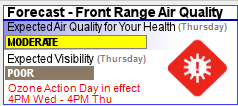Anyone can ftp into this NOAA server to download weather and climate data for free! Check out how easy it is to anonymously ftp into the data server. Use "anonymous" as your username and an email address as your password*.
Grace> ftp nomads.ncdc.noaa.gov
Trying 2610:20:8040:2::166...
Connected to nomads.ncdc.noaa.gov.
220 2610:20:8040:2::166 FTP server ready
Name (nomads.ncdc.noaa.gov:Grace): anonymous
331 Anonymous login ok, send your complete email address as your password
Password:
230-************************************************************
** WARNING ** YOU HAVE ACCESSED A US GOVERNMENT COMPUTER.**
** WARNING ** UNAUTHORIZED USE IS PUNISHABLE BY FINES OR **
** WARNING ** IMPRISONMENT UNDER PUBLIC LAW 99-474. **
** WARNING ** INDIVIDUALS USING THIS COMPUTER SYSTEM ARE **
** WARNING ** SUBJECT TO HAVING THEIR ACTIVITIES ON THIS **
** WARNING ** SYSTEM MONITORED AND RECORDED BY SYSTEM **
** WARNING ** PERSONNEL IN ACCORDANCE WITH ESTABLISHED **
** WARNING ** SECURITY PRACTICES. **
************************************************************
230 Anonymous access granted, restrictions apply
Remote system type is UNIX.
Using binary mode to transfer files.
And look at the available data:Now what do you want to see?
ftp> ls
229 Entering Extended Passive Mode (|||62934|)
150 Opening ASCII mode data connection for file list
drwxrwxr-x 20 3682 nomads-prod 4096 Feb 16 2016 12
drwxrwxr-x 14 3682 3682 4096 Aug 16 11:43 32
drwxrwxr-x 23 3682 nomads-prod 4096 Sep 12 2012 33
drwxr-xr-x 3 root root 4096 Mar 30 2015 CFSR
drwxr-xr-x 2 root root 4096 Mar 30 2015 CFSRR
lrwxrwxrwx 1 root root 7 Aug 26 2013 GDAS -> 12/GDAS
lrwxrwxrwx 1 root root 7 Jun 6 2013 GENS -> 32/gens
drwxr-xr-x 2 root root 4096 Jun 6 2013 GFS
drwxrwxr-x 11 3682 3682 32768 May 8 2015 model
drwxr-xr-x 2 root root 4096 Jun 6 2013 NAM
lrwxrwxrwx 1 root root 7 Jun 6 2013 NARR -> 12/narr
lrwxrwxrwx 1 root root 10 Jun 6 2013 NARR_monthly -> 12/narrmon
lrwxrwxrwx 1 root root 7 Dec 18 2012 NDFD -> 33/ndfd
lrwxrwxrwx 1 root root 8 Aug 23 2013 NDGD -> 33/ndgd/
lrwxrwxrwx 1 root root 3 Sep 23 2013 RAP -> RUC
lrwxrwxrwx 1 root root 15 May 6 2015 reanalysis-2 -> 12/reanalysis-2
-rw-r--r-- 1 root root 26 Oct 13 2010 robots.txt
drwxr-xr-x 2 root root 4096 Dec 16 2015 RUC
drwxr-xr-x 2 root root 4096 Jun 6 2013 SST
-rw-r--r-- 1 root root 610 Mar 23 2011 welcome.msg
226 Transfer complete
ftp>This is where all the weather apps and websites get their data. They just package it up and add advertising or charge you. You can do this yourself with a computer by getting the data from NOAA and the easy-to-use Panoply software from NASA for free.
* You don't have to use your email address, but it is standard courtesy in anonymous ftp to use your email address as a password so that they can log where users are coming from. For instance, if you are a teacher or student, use your school email address so they can log you as an education user. This is how we discover needs and allocate funding.






















